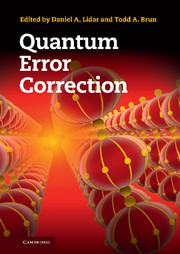Book contents
- Frontmatter
- Contents
- List of contributors
- Prologue
- Preface and guide to the reader
- Acknowledgements
- Part I Background
- Part II Generalized approaches to quantum error correction
- Part III Advanced quantum codes
- 9 Quantum convolutional codes
- 10 Nonadditive quantum codes
- 11 Iterative quantum coding systems
- 12 Algebraic quantum coding theory
- 13 Optimization-based quantum error correction
- Part IV Advanced dynamical decoupling
- Part V Alternative quantum computation approaches
- Part VI Topological methods
- Part VII Applications and implementations
- Part VIII Critical evaluation of fault tolerance
- References
- Index
10 - Nonadditive quantum codes
from Part III - Advanced quantum codes
Published online by Cambridge University Press: 05 September 2013
- Frontmatter
- Contents
- List of contributors
- Prologue
- Preface and guide to the reader
- Acknowledgements
- Part I Background
- Part II Generalized approaches to quantum error correction
- Part III Advanced quantum codes
- 9 Quantum convolutional codes
- 10 Nonadditive quantum codes
- 11 Iterative quantum coding systems
- 12 Algebraic quantum coding theory
- 13 Optimization-based quantum error correction
- Part IV Advanced dynamical decoupling
- Part V Alternative quantum computation approaches
- Part VI Topological methods
- Part VII Applications and implementations
- Part VIII Critical evaluation of fault tolerance
- References
- Index
Summary
Introduction
Most quantum error-correcting codes (QECCs) that are designed to correct local errors are stabilizer codes that correspond to additive classical codes. Because of this correspondence, stabilizer codes are also referred to as additive codes, while nonstabilizer codes are called nonadditive codes. Shortly after the invention of stabilizer codes by Gottesman [G96a] and independently Calderbank et al. [CRS+98], the nonadditive ((5, 6, 2)) code was found [RHS+97], which constitutes the first example of a nonadditive quantum code with a higher dimension than any stabilizer code of equal length and minimum distance. About ten years later, the first one-error-correcting ((9, 12, 3)) code and the optimal ((10, 24, 3)) code were found [YCL+09, YCO07], both better than any stabilizer code of the same length.
Here we describe a framework that not only allows a joint description of these codes, but also enables the construction of new nonadditive codes with better parameters than the best known stabilizer codes. These codes are based on the classical nonlinear Goethals and Preparata codes, which themselves are better than any classical linear code.
In Section 10.3, the framework will be presented from two different points of view, namely union stabilizer codes and codeword stabilized codes, each highlighting different aspects of the construction. To illustrate the relationship of these nonadditive codes to stabilizer codes we first recall the main aspects of the latter. Section 10.4 is devoted to methods for obtaining new codes, including the aforementioned quantum Goethals–Preparata codes.
Information
- Type
- Chapter
- Information
- Quantum Error Correction , pp. 261 - 278Publisher: Cambridge University PressPrint publication year: 2013
Accessibility standard: Unknown
Why this information is here
This section outlines the accessibility features of this content - including support for screen readers, full keyboard navigation and high-contrast display options. This may not be relevant for you.Accessibility Information
- 4
- Cited by
